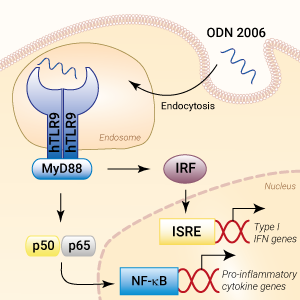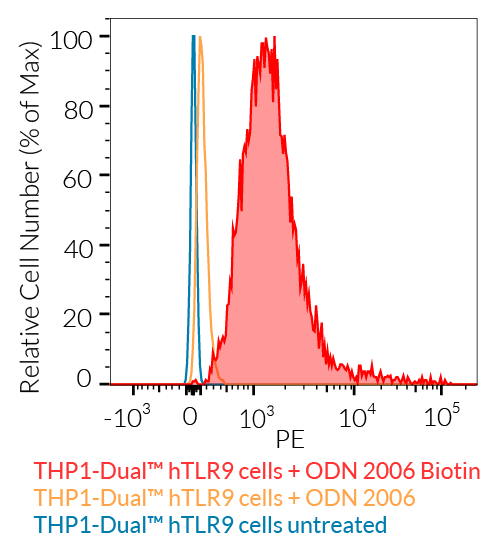ODN 2006 Biotin
| Product | Unit size | Cat. code | Docs. | Qty. | Price | |
|---|---|---|---|---|---|---|
|
ODN 2006 Biotin Class B - Biotin-labeled ODN 2006 |
Show product |
2 x 50 µg |
tlrl-2006b
|
|
Biotin labeled Class B CpG oligonucleotide - Human TLR9-preferred ligand
 InvivoGen also offers:
InvivoGen also offers:
• TLR reporter cells: HEK293, RAW, THP-1 cells
• TLR research tools: Antibodies, Inhibitors, etc.
ODN 2006 Biotin is a labeled version of the ODN 2006 (ODN 7909), a Class B CpG oligonucleotide (ODN). ODN 2006 is a short synthetic single-stranded DNA molecule containing unmethylated CpG dinucleotides (CpG motifs). These unmethylated CpG motifs mimic microbial DNA and act as immunostimulants. ODN 2006 is a ligand of choice for human Toll-like receptor 9 (TLR9).
Mode of action
Stimulatory CpG ODNs are internalized and activate the endosomal receptor TLR9. Activation of TLR9 triggers NF-κB- and interferon regulatory factor (IRF)-mediated pro-inflammatory responses upon the recognition of unmethylated cytosine-phosphorothioate-guanosine (CpG) forms of DNA [1-3]. Unmethylated CpG dinucleotides are a hallmark of microbial (bacterial, viral, fungal, and parasite) DNA and mitochondrial self-DNA [3, 4]. Class B (Type K) CpG ODNs, such as ODN 2006, contain a full phosphorothioate backbone with one or more CpG dinucleotides. They strongly activate B cells but weakly stimulate IFN-α secretion in plasmacytoid dendritic cells [5].
InvivoGen's ODN 2006 Biotin is the labeled version of the ODN 2006, a strong TLR9 agonist verified using our HEK-Blue™ reporter cell lines expressing human or mouse TLR9. ODN 2006 activates the hTLR9-dependent NF-κB and IRF pathways, as assessed using our THP1-Dual™ hTLR9 reporter cell line expressing two reporter genes, for the NF-κB-inducible SEAP and IRF-inducible Lucia luciferase, as well as hTLR9.
ODN 2006 Biotin can be used to evaluate CpG ODN cellular uptake and localization using a biotin detection system, light microscopy, or flow cytometry(see figure). The labeled ODN retains the biological activity.
Key features of ODN 2006 Biotin
- Potent activator of human TLR9
- Biotin-labeled
- Synthetic ODN with unmethylated CpG motifs
- Each lot is functionally tested
![]() Get more information about CpG ODNs Classes.
Get more information about CpG ODNs Classes.
![]() Read our review on TLR9 agonists: double-edged sword for immune therapies.
Read our review on TLR9 agonists: double-edged sword for immune therapies.
References
1. Kumagai Y. et al., 2008. TLR9 as a key receptor of the recognition of DNA. Adv. Drug. Deliv. Rev. 60(7):795-804.
2. Heinz L.X. et al., 2021. TASL is the SLC15A4-associated adaptor for IRF5 activation by TLR7-9. Nature. 581(7808):316-322.
3. Kayraklioglu N. et al., 2021. CpG oligonucleotides as vaccine adjuvants. DNA Vaccines: Methods and Protocols. Methods in Molecular Biology. Vol. 2197. p51-77.
4. Kumar V., 2021. The trinity of cGAS, TLR9, and ALRs: guardians of the cellular galaxy against host-derived self-DNA. Front. Immunol. 11:624597.
5. Krieg A.M. et al., 1995. CpG motifs in bacterial DNA trigger direct B-cell activation. Nature. 374(6522):546-9.
Specifications
Synonyms: ODN 7909, PF_3512676
Specificity: Human TLR9 agonist
Working concentration: 1-5 μM
ODN 2006 sequence: 5’- tcgtcgttttgtcgttttgtcgtt -3’ (24 mer)
Note: Bases are phosphorothioate (nuclease resistant).
Quality control:
- ODN 2006 Biotin has been validated by flow cytometry and cellular assays using HEK-Blue™ TLR9 cells.
- The absence of bacterial contamination (e.g. lipoproteins and endotoxins) has been confirmed using HEK-Blue™ TLR2 and HEK-Blue™ TLR4 cells.
Contents
- 2 x 50μg (6.12 nmol) lyophilized ODN 2006 labeled with biotin at the 3’ terminus
- 2 ml sterile endotoxin-free water
![]() ODN 2006 Biotin is shipped at room temperature
ODN 2006 Biotin is shipped at room temperature
![]() Stored at -20°C. Upon resuspension, prepare aliquots of ODN 2006 Biotin and store at -20°C.
Stored at -20°C. Upon resuspension, prepare aliquots of ODN 2006 Biotin and store at -20°C.
![]() Product is stable 6 months at -20°C when properly stored.
Product is stable 6 months at -20°C when properly stored.
![]() Avoid repeated freeze-thaw cycles.
Avoid repeated freeze-thaw cycles.
Details
CpG ODNs
Synthetic oligodeoxynucleotides containing unmethylated CpG motifs (CpG ODNs), such as ODN 1018, have been extensively studied as adjuvants [1]. These CpG motifs are present at a 20-fold greater frequency in bacterial DNA compared to mammalian DNA [2]. CpG ODNs are recognized by the Toll-like receptor 9 (TLR9), which is expressed on human B cells and plasmacytoid dendritic cells (pDCs), thereby inducing Th1-dominated immune responses [3]. Pre-clinical studies, conducted in rodents and non-human primates, as well as human clinical trials, have demonstrated that CpG ODNs can significantly improve vaccine-specific antibody responses [1]. Three types of stimulatory CpG ODNs have been identified, types A, B, and C, which differ in their immune-stimulatory activities [4-5].
Toll-like receptor 9
The Toll-like Receptor 9 (TLR9) is an endosomal receptor that triggers NF-κB- and interferon regulatory factor (IRF)-mediated pro-inflammatory responses upon the recognition of unmethylated cytosine-phosphorothioate-guanosine (CpG) forms of DNA [6-8]. Unmethylated CpG dinucleotides are a hallmark of microbial (bacterial, viral, fungal, and parasite) DNA, as well as mitochondrial self-DNA [8,9]. These TLR9 agonists can be mimicked by synthetic oligonucleotides containing CpG motifs (CpG ODNs), which have been extensively studied to improve adaptive immune responses in the context of vaccination [6,8].
TLR9 is mainly expressed in subsets of Dendritic Cells and B cells of all mammals. In rodents, but not in humans, TLR9 is also expressed in monocytes and macrophages [8]. The structure of the receptor varies by 24% between human TLR9 (hTLR9) and mouse TLR9 (mTLR9) [8]. They recognize different CpG motifs, the optimal sequences being GTCGTT and GACGTT for hTLR9 and mTLR9, respectively [10].
References:
1. Steinhagen F. et al., 2011. TLR-based immune adjuvants. Vaccine 29(17):3341-55.
2. Hemmi H. et al., 2000. A Toll-like receptor recognizes bacterial DNA. Nature 408:740-5.
3. Coffman RL. et al., 2010. Vaccine adjuvants: Putting innate immunity to work. Immunity 33(4):492-503.
4. Krug A. et al., 2001. Identification of CpG oligonucleotide sequences with high induction of IFN-alpha/beta in plasmacytoid dendritic cells. Eur J Immunol, 31(7): 2154-63.
5. Marshall JD. et al., 2005. Superior activity of the type C class of ISS in vitro and in vivo across multiple species. DNA Cell Biol. 24(2):63-72.
6. Kumagai Y. et al., 2008. TLR9 as a key receptor of the recognition of DNA. Adv. Drug. Deliv. Rev. 60(7):795-804.
7. Heinz L.X. et al., 2021. TASL is the SLC15A4-associated adaptor for IRF5 activation by TLR7-9. Nature. 581(7808):316-322.
8. Kayraklioglu N. et al., 2021. CpG oligonucleotides as vaccine adjuvants. DNA Vaccines: Methods and Protocols. Methods in Molecular Biology. Vol. 2197. p51-77.
9. Kumar V., 2021. The trinity of cGAS, TLR9, and ALRs: guardians of the cellular galaxy against host-derived self-DNA. Front. Immunol. 11:624597.
10. Bauer S. et al., 2001. Human TLR9 confers responsiveness to bacterial DNA via species-specific CpG motif recognition. Proc Natl Acad Sci USA, 98(16):9237-42.







